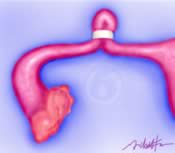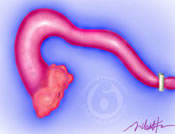Tubal Ligation with Tubal Rings or Tubal Clips
Tubal rings and tubal clips are mechanical methods of tubal ligation applied to the fallopian tubes through a laparoscope. Tubal rings and clips damage minimal lengths of the fallopian tube and are ideal for tubal reversal.
Tubal ligation with tubal rings

Tubal Ring
The tubal ring (also called the Falope ring, Yoon ring, or Lay loop) is a small silastic band placed around a loop of the fallopian tube. With this method of tubal ligation, a 2-3 cm segment of fallopian tube is drawn inside a narrow cone-shaped applicator. The silastic ring (that previously has been stretched over the outside of the applicator) is then released onto the tubal loop. As the ring contracts due to its elasticity, it constricts the base of the loop and blocks the fallopian tube. Deprived of its blood supply, the constricted loop is replaced with scar tissue, and the remaining healthy tubal segments separate, similar to the Pomeroy tubal ligation method. The pregnancy rate is 65% at one year following reversal of tubal ring procedures and continues to rise with the passage of time.
Tubal ligation with tubal clips

Tubal Clip
The spring clip or Hulka Clip (developed in Chapel Hill, North Carolina by Dr. Jaroslav Hulka) also causes mechanical obstruction of the fallopian tube. When open, the hinged clip made of plastic with a gold spring lock, is placed across the narrow muscular or isthmic segment of the fallopian tube close to the uterus. When the clip is compressed, the spring locks the clip tightly across the tube. Because of its narrow width (7 mm), the tubal clip damages the least amount of fallopian tube of any tubal ligation method. Another tubal clip is the Filshie clip that is made of titanium and silastic. The pregnancy rate is 76% at one year following reversal of tubal clip procedures and continues to rise with the passage of time.
Tubal ligation procedures
Normal fallopian tube anatomy and other tubal ligation procedures described in the following pages are:









